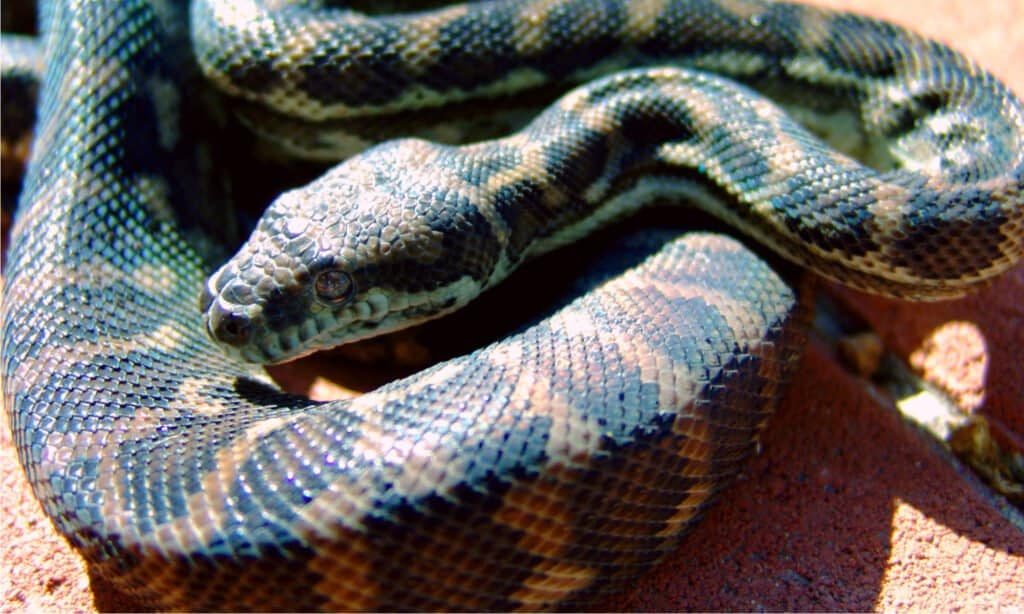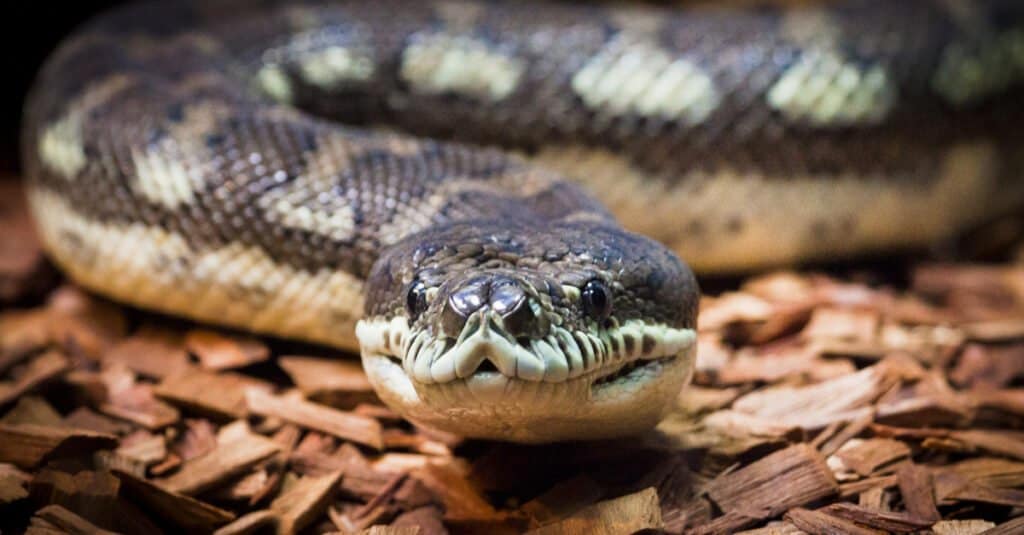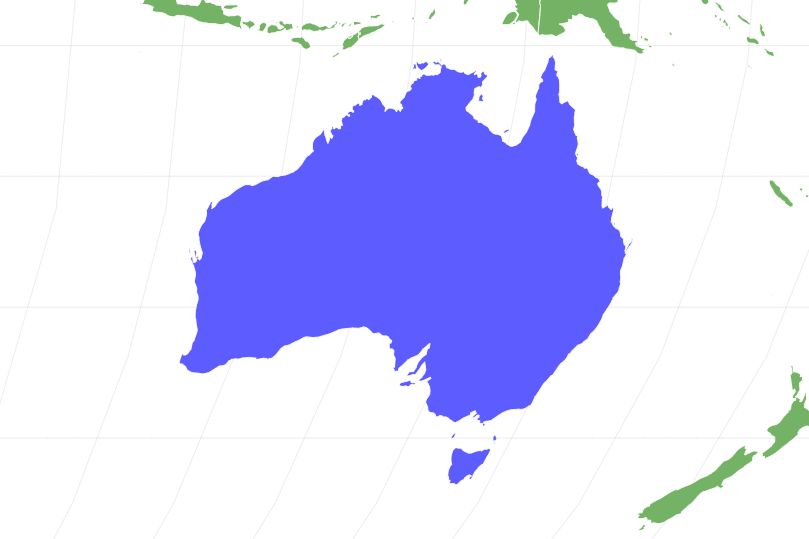Coastal Carpet Python
Morelia spilota mcdowelli
This subspecies can reach 13 feet, but usually tops out at 9 or 10.
Advertisement
Coastal Carpet Python Scientific Classification
- Kingdom
- Animalia
- Phylum
- Chordata
- Class
- Reptilia
- Order
- Squamata
- Family
- Pythonidae
- Genus
- Morelia
- Scientific Name
- Morelia spilota mcdowelli
Read our Complete Guide to Classification of Animals.
Coastal Carpet Python Conservation Status
Coastal Carpet Python Facts
- Prey
- Lizards, birds, rodents, marsupials, bats, sometimes cats, chickens, or small dogs.
- Main Prey
- Rodents and marsupials.
- Name Of Young
- Hatchling
- Group Behavior
- Solitary except during mating season
- Fun Fact
- This subspecies can reach 13 feet, but usually tops out at 9 or 10.
- Estimated Population Size
- Unknown, but it's common
- Biggest Threat
- Habitat destruction
- Most Distinctive Feature
- Varied pattern and colors
- Other Name(s)
- Eastern carpet python
- Incubation Period
- ~50-60 days
- Age Of Independence
- At hatching
- Diet
- Omnivore
- Average Litter Size
- 5-50
- Lifestyle
- Nocturnal
- Diurnal
- Favorite Food
- Rodents and marsupials
Coastal Carpet Python Physical Characteristics
- Color
- Brown
- Grey
- Yellow
- Fawn
- Black
- White
- Tan
- Dark Brown
- Cream
- Orange
- Skin Type
- Scales
- Lifespan
- 20+ years
- Length
- 9-10 feet but up to 13
- Age of Sexual Maturity
- 2-4 years
- Venomous
- No
- Aggression
- Low
View all of the Coastal Carpet Python images!
The Coastal carpet python, a subspecies of carpet python, is widespread from the northern tip of Queensland at Cape York all the way to northeast New South Wales.
It is one of the largest carpet python subspecies and is regularly found wintering in the roof spaces and walls of homes in urban areas. This snake varies widely in color and pattern and is a popular pet among herpetoculturists.
5 Amazing Facts About Coastal Carpet Pythons
- These snakes are opportunistic carnivores that will eat whatever they can overpower.
- Coastal carpet pythons are the largest subspecies of carpet pythons and average between 9 and 10 feet long.
- These might be the most common snake found in and near Brisbane, Australia.
- The largest coastal carpet pythons can measure over 13 feet.
- There are natural intergrades between this subspecies and others at the borders of its range where it overlaps another carpet python’s range.
Where to find Coastal Carpet Pythons
This carpet python subspecies is at home in many habitats and might be found draped across tree limbs, coiled up in undergrowth, or out in the open on the ground. This adventurous snake also lives in the roof spaces or walls of houses, rainforests, eucalyptus forests, pastures, heaths, and many urban areas.
Coastal carpet pythons are active day or night, whenever their prey is available and temperatures are comfortable for them. These snakes mainly eat possums, rats, flying foxes, birds, and occasionally domestic poultry, guinea pigs, cats, and small dogs. Sometimes they try to eat a cane toad which, for them, is fatal.
Reproduction
The mating season for coastal carpet pythons is during the spring. Females produce pheromones that attract several males to them. In order to figure out who gets to mate with her, those males compete by wrestling and fighting with one another. There aren’t usually any injuries from the wrestling matches, and typically the strongest or biggest male gets mating rights.
After mating, the female lays anywhere between 5 and 50 eggs. The larger the female, the more eggs she will lay. Like many other pythons, the female coastal carpet python coils around her eggs to protect and help incubate them until hatching. During this time, she will not eat and only leaves the eggs to bask for short periods of time. The eggs hatch about 60 days later.
Scientific Name and Classification
Coastal carpet pythons are nonvenomous members of the family Pythonidae. At last count, there are approximately 40 species in the family, but that number can change as scientists do more research. Many pythons, like this one, are classified as subspecies.
This snake’s scientific name is Morelia spilota mcdowelli. Spilota means spotted, and mcdowelli refers to the individual that Wells and Wellington named it after when they first described it in 1984. There is level of difficulty inherent with classifying these snakes, however. It’s due to the fact that on the borders of their range, there are natural intergrades, or hybrids, between the subspecies. So, snakes on, say, the southern border may have characteristics of both Morelia s. spilota and Morelia s. mcdowelli. Then, those in the northern parts of its range may have characteristics of this snake and another M. spilota subspecies. In truth, we need more research on the carpet python complex to understand the genetics and their relationships to one another.
Population and Conservation Status
Like the other subspecies, coastal carpet pythons aren’t listed separately in the IUCN Redlist of Threatened Species. As a whole, carpet pythons are listed with IUCN as a species of least concern. Yet, there are locations where this subspecies is abundant and where they have decreased noticeably.
Although these and other carpet pythons are common pets, Australia outlawed the export of these snakes and other native animals. So, any of them outside of their native country are probably captive-bred. However, there is an illegal network of animal traders who smuggle these and other species out of Australia.
Identifying the Coastal Carpet Python: Appearance and Description
The coastal carpet python is the largest of the carpet python complex. This snake has a muscular body that averages 9-10 feet long, and the females get bigger than the males. Its belly is creamy-white to yellow, and its dorsal scales are smooth and glossy. It varies from olive green to brown or tan with lighter colored stripes or blotches. However, its pattern is highly variable.
This snake has a large, triangular head with a blunted snout. Its thermo-receptive pits are large and noticeable along the front of its snout, under its nostrils, and at the rear of its lower jaw. The scales on its head are very small and make it look grainy, and it has large eyes with vertical pupils.

Coastal carpet pythons’ patterns and colors can vary dramatically from one individual to the next.
©sharyn/Shutterstock.com
Pictures and Videos of Coastal Carpet Pythons

At up to 4 meters, it is the largest subspecies of Carpet Python and is found in Queensland and New South Wales in Australia.
©Jason Benz Bennee/Shutterstock.com

These snakes’ varying patterns help them camouflage, and they become almost invisible.
©Firepac/Shutterstock.com
How Dangerous is the Coastal Carpet Python
To your smaller pets, chickens, etc, this snake could be a threat; its opportunistic feeding habits make it willing to take anything it can fit in its mouth. Otherwise, they’re fabulous rodent control and really should be left to do what they do best.
Like other pythons, these snakes are nonvenomous. Their bites generally don’t pose any immediate danger, but they bite hard and can sometimes leave teeth behind in the wound. If you’re bitten by one, first clean the wound, so it doesn’t become infected. Second, make sure the snake didn’t leave a tooth left behind.
Coastal Carpet Python Behavior and Humans
These snakes are generally easy-going, good-natured snakes. However, like any wild animal, they are sometimes unpredictable. This subspecies tends to be a little crankier than others, like the diamond python. They are more likely to snap and exhibit some aggressive behavior, but they may just startle more easily.
Owing to their arboreal nature, coastal carpet pythons are excellent climbers. They often find themselves in odd predicaments – sleeping inside the walls of a house or draped across the rafters, for example. They are widespread and common across their range, and people encounter them fairly regularly. Their beauty and typically easy-going personalities make them popular pets.
Similar Animals
With as many python species as there are, it’s astounding that 14 of them occur in Australia alone. Here are a few:
- The spotted python is one of the smallest pythons in the world, from the Antaresia genus.
- You’ll find that the Amethystine python, known in Australia as the scrub python, has caused its share of havoc during mating season.
- Black-headed pythons are named appropriately; their black heads help them capture more heat.
Coastal Carpet Python FAQs (Frequently Asked Questions)
How big do coastal carpet pythons get?
These are the biggest of the carpet pythons, they usually grow to about 9-10 feet long, with the females being the biggest. However, there have been a few recorded at 13+ feet long.
Are coastal carpet pythons dangerous or venomous?
They’re not venomous – they’re a species of python. These snakes kill by constriction, not venom. That said, a really big one could be hard to handle but likely not dangerous for a person.
What do coastal carpet pythons eat?
They’re opportunistic carnivores. Like all snakes, coastal carpet pythons are obligate carnivores. That means that they get all their nutrients from the food they eat, and that it must all be meat-based. They mainly eat rodents and marsupials, but also take bats, birds, and other warm-blooded prey that’s small enough for them to swallow.
How do coastal carpet pythons hunt?
Most snakes use ambush methods to strike, these snakes are no different. While they do occasionally forage actively, they are very likely to lie in wait for days, waiting for the perfect opportunity.
Where do coastal carpet pythons live?
Only in Australia. Specifically, the eastern coast of the continent in Queensland and New South Wales.
Thank you for reading! Have some feedback for us? Contact the AZ Animals editorial team.
Sources
- Morelia, Carpet Pythons and their Allies | Reptile Focus, Available here: http://www.repfocus.dk/Morelia.html
- Morelia spilota | IUCN Redlist of Threatened Species, Available here: https://www.iucnredlist.org/species/62232/21649539
- Morelia spilota | Reptile Database, Available here: https://reptile-database.reptarium.cz/species?genus=Morelia&species=spilota
- Carpet Python | SeaWorld, Available here: https://seaworld.org/animals/facts/reptiles/carpet-python/

















